Book contents
- Thecla and Medieval Sainthood
- Thecla and Medieval Sainthood
- Copyright page
- Contents
- Contributors
- Acknowledgments
- Abbreviations
- Introduction
- Part I An Act to Follow
- Chapter 1 A Cainite Invocation of Thecla?
- Chapter 2 Saint Thecla in Geʿez Hagiographical Literature
- Chapter 3 Versified Martyrs
- Chapter 4 The Reception of the Acts of Thecla in Armenia
- Chapter 5 Thecla beyond Thecla
- Chapter 6 Shifting the Poetics of Gender Ambiguity
- Part II An Act to Surpass
- Afterword
- Appendix Summaries of Texts
- Index
- References
Chapter 4 - The Reception of the Acts of Thecla in Armenia
Thecla as a Model of Representation for Holy Women in Ancient Armenian Literature
from Part I - An Act to Follow
Published online by Cambridge University Press: 06 May 2022
- Thecla and Medieval Sainthood
- Thecla and Medieval Sainthood
- Copyright page
- Contents
- Contributors
- Acknowledgments
- Abbreviations
- Introduction
- Part I An Act to Follow
- Chapter 1 A Cainite Invocation of Thecla?
- Chapter 2 Saint Thecla in Geʿez Hagiographical Literature
- Chapter 3 Versified Martyrs
- Chapter 4 The Reception of the Acts of Thecla in Armenia
- Chapter 5 Thecla beyond Thecla
- Chapter 6 Shifting the Poetics of Gender Ambiguity
- Part II An Act to Surpass
- Afterword
- Appendix Summaries of Texts
- Index
- References
Summary
In the first half of the fifth century, at the origins of Armenian literature, an anonymous author translated the apocryphal Acts of Thecla from the Syriac version of the Greek text (second century). The translation rapidly furthered the spread of the legend across Armenia. In that same century, three works written directly in Armenian presuppose the legend of Thecla. This article focuses on the narrative patterns and the ways in which the paradigms of holiness embodied by Thecla have influenced the representation of holy women who, in the Armenian tradition, are associated with the fundamental stages of the Christianization of Armenia. Thecla, indeed, served as a model of female sanctity along three important lines, namely as holy virgin, teacher and apostle, and martyr. As the venerated proto-martyr, she served as a model for the first female martyrs in the history of Armenian Christianity, respectively, in the apostolic age (Sanduxt) and at the time of the foundation of the Church of Armenia (Hṙip‘simē). The model of holy female apostle is found in the Armenian Martyrdom of Photine too. The Armenian tradition also contributed to the development of the legend and helped to make of Thecla a holy protector of Nicene orthodoxy.
Keywords
- Type
- Chapter
- Information
- Thecla and Medieval Sainthood<I>The Acts of Paul and Thecla</I> in Eastern and Western Hagiography, pp. 110 - 141Publisher: Cambridge University PressPrint publication year: 2022



